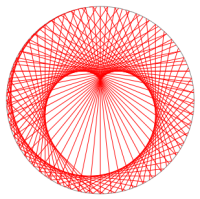$k$ squares problem
Let’s fix a natural number \(k\). How many ways can we decompose \(n\) into \(k\) squares? It’s an interesting problem and it should help me understand automorphic forms better.
Let \(w_k(n)\) be the number of tuples \((n_1, \cdots, n_k)\in \mathbb{Z}^k\) such that \(n_1^2+\cdots+n_k^2=n\). Let \(g_k(q)\) be the generating function of \(w_k(n)\), i.e., \[g_k(q)=\sum_{n \in \mathbb{N}} w_k(n)q^n.\] Then, \[\begin{split} g_k(q) &= \sum_{n \in \mathbb{N}} w_k(n)q^n \\ &= \sum_{n \in \mathbb{N}} \sum_{\substack{n_1, \cdots, n_k \in \mathbb{Z} \\ n_1^2+\cdots+n_k^2=n}}q^n \\ &= \sum_{n_1, \cdots, n_k \in \mathbb{Z}} q^{n_1^2+\cdots+n_k^2} \\ &= \left(\sum_{n \in \mathbb{Z}} q^{n^2}\right)^k \\ &= (g_1(q))^k. \end{split}\]
Set \(q=e^{\pi iz}\), where \(z \in \mathcal{H}\), the upper complex plane. Let \[\theta(z)=g_1(e^{\pi iz})=\sum_{n \in \mathbb{Z}} e^{\pi in^2z}.\] It’s clear that \(\theta(z+2)=\theta(z)\). This means \(\theta\) is invariant under \(T^2=\left(\begin{array}{cc} 1 & 2 \\\\ & 1 \end{array}\right)\), where \(T=\left(\begin{array}{cc} 1 & 1 \\\\ & 1 \end{array}\right)\). Let \(S=\left( \begin{array}{cc} & -1 \\\\ 1 & \end{array}\right)\). Let y be a positive real number, then \[\theta(iy)=\sum_{n \in \mathbb{Z}}e^{-\pi in^2y}.\]
Using the following two facts:
- If \(f_t(x)=e^{-\pi itx^2}\), then \(\hat{f_t}=\frac{1}{\sqrt{t}}f_{1/t}\).
- Poisson summation formula.
We can get \(\theta\left(-\frac{1}{iy}\right)=\sqrt{y}\theta(iy)\). By analytic continuation, the equation gives \[\theta\left(-\frac{1}{z}\right)=\sqrt{-iz}\theta(z).\] If we define \(f={\theta}^{8l}\) for some positive integer \(l\), we have \[\begin{array}{l} f(z+2)=f(z) \\ f(-1/z)=z^{4l}f(z) \end{array}\] Letting \(\Gamma_{\theta}\) be generated by \(T^2\) and \(S\), combining the two equations above, we conclude that \(f\) is a modular form of weight \(4l\) for \(\Gamma_{\theta}\). Up to this point, we have successfully converted a problem in number theory to a study about modular forms. I believe this is one motivation for studying modular forms.
Let \(m\) be an even number larger than or equal \(4\). Then the Eisenstein series \(E_m \in M_m(\Gamma(1))\), where \(M_m(\Gamma(1))\) is the space of all modular forms of weight \(m\) for \(\Gamma(1)=SL(2,\mathbb{Z})\). And, \[\begin{split} E_m(z) &= \frac{1}{2}\sum_{\substack{c,d\in\mathbb{Z} \\\\ (c,d)\ne(0,0)}} (cz+d)^{-m} \\ &= \zeta(m)+\frac{(2\pi i)^m}{(m-1)!}\sum_{n=1}^{\infty} \sigma_{m-1}(n)e^{2\pi inz}, \end{split}\] where \(\zeta(m)=\sum_{n=1}^{\infty}n^{-m}\) and \(\sigma_{m-1}(n)=\sum_{d|n} d^{m-1}\). We can normalize the constant term of \(E_m\) to be 1, defining \(G_m=\zeta(m)^{-1}E_m\).
Now let \(l=1\). Then \(f=\theta^8\) is a modular form of weight \(4\) for \(\Gamma_{\theta}\). It’s would be a guess that \(f\) might be a multiple of \(G_4=1+240\sum_{n=1}^{\infty}\sigma_3(n)e^{2\pi inz}\). But it’s not. However, \(f\) relates to \(G_4\) by the following equation, whose proof can be found in Chapter VII in Freitag and Busam’s book Complex Analysis: \[\begin{equation}f(z)=\frac{1}{15}\left(16G_4(z)-G_4\left(\frac{z+1}{2}\right)\right). \label{eq} \end{equation}\]
Note that \(f=\theta^8=g_8\), so \(\eqref{eq}\) solves the 8 squares problem: \[w_8(n)=\left\{ \begin{array}{ll} 16\sigma_3(n), &\text{ if } n \text{ is odd,} \\ 256\sigma_3\left(\frac{n}{2}\right)-16\sigma_3(n), &\text{ if } n \text{ is even.} \end{array} \right.\]
